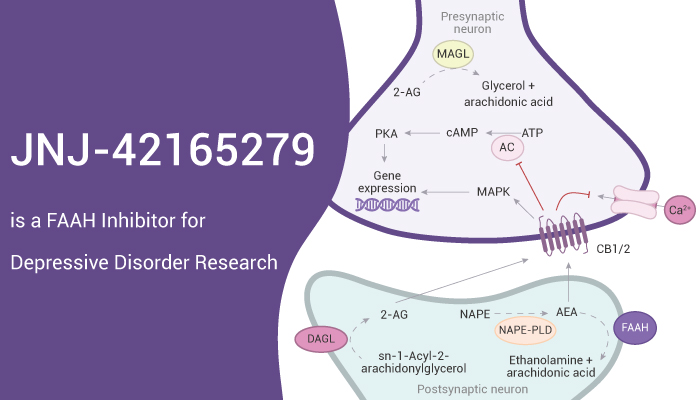Fatty acid amide hydrolase (FAAH) is an integrase that can hydrolyze endogenous cannabinoid anandamide and related acylated signaling lipids. Besides, FAAH belongs to the serine hydrolase amide enzyme characteristic (AS) superfamily. Moreover, FAAH rapidly degrades various fatty acid ethanolamides, including FAAH’s main substrates AEA (N-arachidonic acid ethanolamide or anandamide), PEA (N-palmitoyl ethanolamide), and OEA (N-oleoyl ethanolamide). Furthermore, FAAH terminates AEA signaling by hydrolyzing AEA lipids into arachidonic acid and ethanolamine (two metabolites that do not activate CB1 or CB2 receptors). Meanwhile, FAAH not only hydrolyzes AEA, but also regulates other lipid signaling molecules with anti-inflammatory and analgesic properties. Today, we will introduce a FAAH inhibitor, JNJ-42165279.

JNJ-42165279 is a FAAH Inhibitor for Depressive Disorder Research.
First of all, JNJ-42165279 is a FAAH inhibitor with IC50 of 70 nM and 313 nM for hFAAH and rFAAH, respectively. Nonetheless, JNJ-42165279 covalently inactivates the FAAH enzyme, but is highly selective with regard to other enzymes, ion channels, transporters, and receptors.
In the second place, JNJ-42165279 exhibits excellent ADME and pharmacodynamic properties. Importantly, JNJ-42165279 blocks FAAH in the brain and periphery of rats and thereby cause an elevation of the concentrations of AEA, OEA, and PEA. In addition, JNJ-42165279 exhibited relatively rapid clearance in the course of rat pharmacokinetic experiments, manifesting as a low AUC and Cmax.
Finally, JNJ-42165279 is a FAAH inhibitor for depressive disorder research.
References:
Keith JM, et al. ACS Med Chem Lett. 2015 Nov 2;6(12):1204-8.